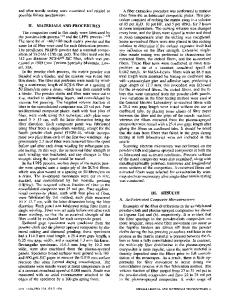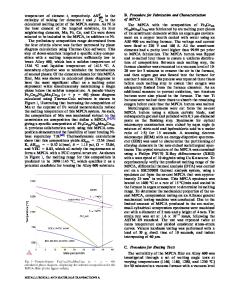Microstructural Architecture, Microstructures, and Mechanical Properties for a Nickel-Base Superalloy Fabricated by Elec
- PDF / 3,436,860 Bytes
- 18 Pages / 593.972 x 792 pts Page_size
- 57 Downloads / 350 Views
CKEL-BASE superalloys, essentially c (fcc), NiCr solid solution strengthened by additions of Al, Ti, Mo, Ta, and Nb to precipitate a coherent, ordered fcc metastable phase c¢ (Ni3(Al, Ti, Nb)) or c¢¢ (bct) phase (Ni3Nb),[1] comprise a broad range of compositions, which have found widespread applications over the past half century. Examples of the more prominent and contemporary applications include jet engine components such as turbine blades, high speed airframe parts, and fossil fuel and nuclear power plant components. These alloys also find a wide variety of corrosion and elevated temperature oxidation envi-
ronment applications, especially CUSTOM-AGE 625* *CUSTOM-AGE 625 is a registered trademark of Carpenter Technology Corp., Reading, PA.
plus and ALLOY 625**, which are superior to
**ALLOY 625 is a registered trademark of Carpenter Technology Corp., Reading, PA.
INCONEL 718 ,[2] and used in refinery and chemical INCONEL 718 is a trademark of Special Metals Corporation, New Hartford, NY.
L.E. MURR, Professor and Chairman, E. MARTINEZ, P.W. SHINDO, and J.L. MARTINEZ, Undergraduate Research Assistants, S.M. GAYTAN, D.A. RAMIREZ, and B.I. MACHADO, Graduate Research Assistants, are with the Department of Metallurgical and Materials Engineering, The University of Texas at El Paso, El Paso, TX 79968. Contact e-mail: [email protected] F. MEDINA, Manager, and R.B. WICKER, Professor and Director, are with the W.M. Keck Center for 3D Innovation, The University of Texas at El Paso. J. WOOTEN, President, and D. CISCEL, Vice President, are with CalRAM, Inc., Simi Valley, CA 93065. U. ACKELID, Senior Scientist, is with Arcam AB, Mo¨lndal SE-431-37, Sweden. Manuscript submitted December 20, 2010. Article published online June 15, 2011 METALLURGICAL AND MATERIALS TRANSACTIONS A
process industries.[3–9] Directional (or unidirectional) solidification processing[10] was extensively applied in the production of aligned eutectic structures, directional columnar structures, and single-crystal Ni-base superalloy turbine blades. These single-crystal turbine blades solidify with a dendritic structure containing microsegregation and second-phase (c¢) particles formed by eutectic reactions. In eutectic alloys with reinforced composite properties, a planar VOLUME 42A, NOVEMBER 2011—3491
solid-liquid (phase equilibrium) interface can be established for ingot solidification of eutectic composition carried out under a steep axial thermal gradient achieved by slow withdrawal of the ingot from a furnace such that uniaxial heat flow conditions are established.[11] When this occurs, the two solid eutectic reaction phases (matrix/ eutectic) deposit at the liquid/solid interface and grow parallel to the direction of movement of this reaction front. Consequently, two phases are formed oriented in (or parallel to) the direction of solidification. This often forms eutectic fibers, embedded in the continuous matrix, or parallel lamellae of each phase. Variations in solidification rates of the two phases into the melt create variances in the microstructu
Data Loading...











